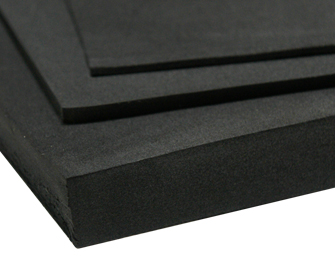|
|
Neoprene foam is a lighter and less dense material when compared to solid neoprene. Because of this, it is able to provide a higher degree of compressibility. Neoprene foam retains a lower tensile strength and is not suitable for abrasive conditions but is ideal for applications that require heavy compression. Like its solid form, neoprene foam sheets are resistant to the damaging effects of harsh solvents including chemicals and oil; however, open and closed cell soft neoprene foam have varying levels of moisture-resistance. Closed cell neoprene rubber sheets are more resistant to moisture than its open cell counterpart allowing it to be used in marine settings or industrial applications involving moisture. On the other hand, open cell neoprene is better suited for energy absorption; a foam neoprene pad can be used to help dampen sound. Additionally, soft neoprene foam has a wide operating temperature range, being able to withstand temperatures as high as 200 degrees Fahrenheit.

|

|
What is Neoprene Foam?
Neoprene foam is the cellular form of solid neoprene and is characterized by numerous pockets of air within its structure. Neoprene foam is made when gases, such as nitrogen, are introduced to the material during its production process which creates the pockets of air in its structure. Due to its air-filled composition, neoprene foam sheets are highly compressible. This soft neoprene material is more compressible than solid neoprene, can offer better insulation, and retains excellent energy absorption properties. In addition, neoprene foam is resistant to the damaging effects of ozone, oxidation, chemicals, oil, and extreme temperatures up to 200 degrees Fahrenheit. There are two types of neoprene foam: closed cell and open cell. Each type of neoprene foam has different chemical and physical properties that are brought on by the difference in structures; however, neoprene foam sheets are ideal for most general-purpose applications.
Is Neoprene a Closed Cell Foam?
One form of neoprene foam is closed cell and it is characterized by its tight-knit composition of air pockets. Closed cell neoprene foam is a flexible and highly compressible material that is commonly used as seals and gaskets for high-pressure applications making a closed cell neoprene pad a much more compressible option than solid neoprene rubber sheets. Closed cell foam is also moderately resistant to staining caused by exposure to oil or gas. This resistance quality makes closed cell neoprene foam an extremely durable and reliable material that will retain its strength even when exposed to harsh solvents. Due to its tight-knit structure, closed cell neoprene foam sheets are highly moisture-resistant having an absorption level of less than 5%. Due to its moisture-resistance, closed cell neoprene foam can be used in applications involving water, including salt water, without absorbing it or deteriorating.
What is Open Cell Neoprene?
Open cell neoprene foam, as its name suggests, is characterized by the large pockets of air within its composition. Compared to closed cell neoprene, this soft neoprene material is much more porous due to its larger air pockets. Although these air pockets make open cell neoprene foam unfit for applications involving moisture, they allow energy and matter to better disperse within the composition of the material. Due to these characteristics of open cell neoprene, “open cell foam is generally more flexible than closed cell foam and can more easily conform to sealing applications. It can be less durable than closed cell options, though” (rubberlibrary.com). This property of open cell neoprene foam makes it a great option for sound dampening applications. For instance, an open cell neoprene pad can be placed under a vibrating or moving object to help dampen the noise created by dispersing the energy of sound within its airy structure. Due to its permeable nature, open cell neoprene foam is better suited for dry applications, such as sound dampening, rather than applications involving moisture.
What is the Difference Between Closed Cell and Open Cell Foam?
The primary difference between closed cell and open cell neoprene foam is their structure which dictates their permeability and density. This difference between the two types of neoprene foam determines which applications they can and cannot be used. For instance, “Open-cell sponge rubber contains open, interconnected pockets that permit the passage of air, water, and other chemicals when the material is not compressed. Closed-cell sponge rubber contains balloon-like cells that hold nitrogen gas and thus prevent the passage of these substances at low pressures” (linkedin.com). Because closed cell neoprene has a tight-knit structure of air pockets, it is much more difficult to permeate through the material making it suitable for applications involving moisture. Furthermore, closed cell neoprene foam generally has higher compressive strengths and lower absorption rates that open cell foam; this allows for greater structural potency over that of open cell neoprene. Open cell neoprene is extremely permeable, which allows energy to be evenly distributed within the composition of the material while still maintaining the structural integrity of the neoprene foam. The porous structure of an open cell neoprene pad traps and rebounds energy within its interconnected pockets and eventually allows the energy to disperse. Despite these differences, neoprene foam, both closed cell and open cell, retains better compression, insulation, and energy-absorption when compared to solid neoprene rubber sheets.

|

|
These qualities of closed and open cell neoprene foam allow them to be used in applications solid neoprene cannot. Solid neoprene rubber sheets are much denser and not as flexible or pliable as cellular neoprene and will not perform well in highly compressive applications. Each type of neoprene foam is better suited for different applications. Closed cell neoprene is best suited for moisture-resistance while its open cell form is better for energy absorption, such as sound reduction. Despite their differences, due to their airy structures, both forms of neoprene foam sheets are able to provide better compressibility while also being resistant to degrading solvents and conditions, such as oil, chemicals, and extreme heat.
What is Neoprene Foam?
|
|
|